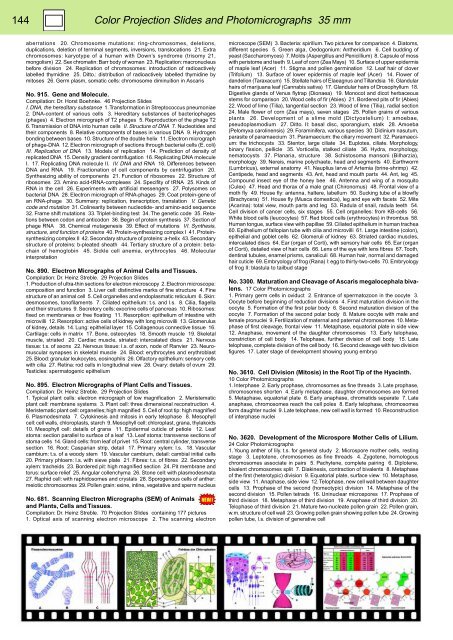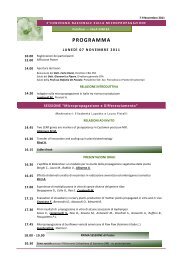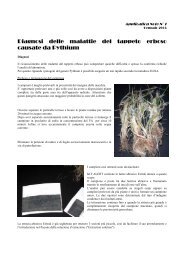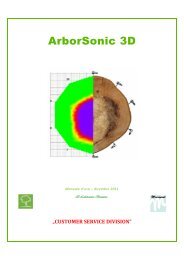BIOLOGY - microscopia.info
BIOLOGY - microscopia.info
BIOLOGY - microscopia.info
You also want an ePaper? Increase the reach of your titles
YUMPU automatically turns print PDFs into web optimized ePapers that Google loves.
144<br />
Color Projection Slides and Photomicrographs 35 mm<br />
aberrations 20. Chromosome mutations: ring-chromosomes, deletions,<br />
duplications, deletion of terminal segments, inversions, translocations 21. Extra<br />
chromosomes: karyotype of a human with Down’s syndrome (trisomy 21,<br />
mongolism) 22. Sex chromatin: Barr body of woman 23. Replication: macronucleus<br />
before division 24. Replication of chromosomes: introduction of radioactively<br />
labelled thymidine 25. Ditto.: distribution of radioactively labelled thymidine by<br />
mitoses 26. Germ plasm, somatic cells: chromosome diminuition in Ascaris<br />
No. 915. Gene and Molecule.<br />
Compilation: Dr. Horst Boehnke. 46 Projection Slides<br />
I. DNA, the hereditary substance 1. Transformation in Streptococcus pneumoniae<br />
2. DNA-content of various cells 3. Hereditary substances of bacteriophages<br />
(phages) 4. Electron micrograph of T2 phages 5. Reproduction of the phage T2<br />
6. Transmission of DNA into human cells II. Structure of DNA 7. Nucleotides and<br />
their components 8. Relative components of bases in various DNA 9. Hydrogen<br />
bonding between bases 10. Structure of the double helix 11. Electron micrograph<br />
of phage-DNA 12. Electron micrograph of sections through bacterial cells (E. coli)<br />
III. Replication of DNA 13. Models of replication 14. Prediction of density of<br />
replicated DNA 15. Density gradient centrifugation 16. Replicating DNA molecule<br />
I. 17. Replicating DNA molecule II. IV. DNA and RNA 18. Differences between<br />
DNA and RNA 19. Fractionation of cell components by centrifugation 20.<br />
Synthesizing ability of components 21. Function of ribosomes 22. Structure of<br />
ribosomes 23. Amino acid-tRNA-complexes 24. Specifity of tRNA 25. Kinds of<br />
RNA in the cell 26. Experiments with artificial messengers 27. Polysomes on<br />
bacterial DNA 28. Electron micrograph of RNA-phages 29. Coat protein-gene of<br />
an RNA-phage 30. Summary: replication, transcription, translation V. Genetic<br />
code and mutation 31. Colinearity between nucleotide- and amino-acid sequence<br />
32. Frame shift mutations 33. Triplet-binding test 34. The genetic code 35. Relations<br />
between codon and anticodon 36. Begin of protein synthesis 37. Section of<br />
phage RNA 38. Chemical mutagenesis 39. Effect of mutations VI. Synthesis,<br />
structure, and function of proteins 40. Protein-synthesizing complex I 41. Proteinsynthesizing<br />
complex II 42. Secondary structure of proteins: a-helix 43. Secondary<br />
structure of proteins: b-pleated sheath 44. Tertiary structure of a protein: betachain<br />
of hemoglobin 45. Sickle cell anemia, erythrocytes 46. Molecular<br />
interpretation<br />
No. 890. Electron Micrographs of Animal Cells and Tissues.<br />
Compilation: Dr. Heinz Streble. 29 Projection Slides<br />
1. Production of ultra-thin sections for electron microscopy 2. Electron microscope:<br />
composition and function 3. Liver cell: distinctive marks of fine structure 4. Fine<br />
structure of an animal cell 5. Cell organelles and endoplasmatic reticulum 6. Skin:<br />
desmosomes, tonofilaments 7. Ciliated epithelium: t.s. and l.s. 8. Cilia, flagella<br />
and their structures 9. Secretory cells: exocrine cells of pancreas 10. Ribosomes:<br />
fixed on membranes or free floating 11. Resorption: epithelium of intestine with<br />
microvilli 12. Resorption: active cells of kidney with long microvilli 13. Glomerulus<br />
of kidney, details 14. Lung: epithelial layer 15. Collagenous connective tissue 16.<br />
Cartilage: cells in matrix 17. Bone, osteocytes 18. Smooth muscle 19. Skeletal<br />
muscle, striated 20. Cardiac muscle, striated: intercalated discs 21. Nervous<br />
tissue: t.s. of axons 22. Nervous tissue: l.s. of axon, node of Ranvier 23. Neuromuscular<br />
synapses in skeletal muscle 24. Blood: erythrocytes and erythroblast<br />
25. Blood: granular leukocytes, eosinophils 26. Olfactory epithelium: sensory cells<br />
with cilia 27. Retina: rod cells in longitudinal view 28. Ovary: details of ovum 29.<br />
Testicles: spermatogenic epithelium<br />
No. 895. Electron Micrographs of Plant Cells and Tissues.<br />
Compilation: Dr. Heinz Streble. 29 Projection Slides<br />
1. Typical plant cells: electron micrograph of low magnification 2. Meristematic<br />
plant cell: membrane systems 3. Plant cell: three dimensional reconstruction 4.<br />
Meristematic plant cell: organelles; high magnified 5. Cell of root tip: high magnified<br />
6. Plasmodesmata 7. Cytokinesis and mitosis in early telophase 8. Mesophyll<br />
cell: cell walls, chloroplasts, starch 9. Mesophyll cell: chloroplast, grana, thylakoids<br />
10. Mesophyll cell: details of grana 11. Epidermal cuticle of petiole 12. Leaf<br />
stoma: section parallel to surface of a leaf 13. Leaf stoma: transverse sections of<br />
stoma cells 14. Gland cells: from leaf of privet 15. Root: central cylinder, transverse<br />
section 16. Root: Casparian strip, detail 17. Primary xylem: l.s. 18. Vascular<br />
cambium: t.s. of a woody stem 19. Vascular cambium, detail: cambial initial cells<br />
20. Primary phloem: l.s. with sieve plate 21. Fibres: t.s. of fibres 22. Secondary<br />
xylem: tracheids 23. Bordered pit: high magnified section 24. Pit membrane and<br />
torus: surface relief 25. Angular collenchyma 26. Stone cell: with plasmodesmata<br />
27. Raphid cell: with raphidosomes and crystals 28. Sporogenous cells of anther:<br />
meiotic chromosomes 29. Pollen grain: exine, intine, vegetative and sperm nucleus<br />
No. 681. Scanning Electron Micrographs (SEM) of Animals<br />
and Plants, Cells and Tissues.<br />
Compilation: Dr. Heinz Streble. 70 Projection Slides containing 177 pictures<br />
1. Optical axis of scanning electron microscope 2. The scanning electron<br />
microscope (SEM) 3. Bacteria: spirillum. Two pictures for comparison 4. Diatoms,<br />
different species 5. Green alga, Oedogonium: Antheridium 6. Cell budding of<br />
yeast (Saccharomyces) 7. Molds (Aspergillus and Penicillium) 8. Capsule of moss<br />
with peristome and teeth 9. Leaf of corn (Zea Mays) 10. Surface of upper epidermis<br />
of maple leaf (Acer) 11. Stigma and pollen germination 12. Leaf hair of clover<br />
(Trifolium) 13. Surface of lower epidermis of maple leaf (Acer) 14. Flower of<br />
dandelion (Taraxacum) 15. Stellate hairs of Elaeagnus and Tillandsia 16. Glandular<br />
hairs of marijuana leaf (Cannabis sativa) 17. Glandular hairs of Drosophyllum 18.<br />
Digestive glands of Venus flytrap (Dionaea) 19. Monocot and dicot herbaceous<br />
stems for comparison 20. Wood cells of fir (Abies) 21. Bordered pits of fir (Abies)<br />
22. Wood of lime (Tilia), tangential section 23. Wood of lime (Tilia), radial section<br />
24. Male flower of corn (Zea mays), seven stages 25. Pollen grains of various<br />
plants 26. Development of a slime mold (Dictyostelium) I: amoebae,<br />
pseudoplasmodium 27. Ditto. II: basal disc, sporangium, stalk 28. Amoeba<br />
(Pelomyxa carolinensis) 29. Foraminifera, various species 30. Didinium nasutum,<br />
parasite of paramaecium 31. Paramaecium: the ciliary movement 32. Paramaecium:<br />
the trichocysts 33. Stentor, large ciliate 34. Euplotes, ciliate. Morphology,<br />
binary fission, pellicle 35. Vorticella, stalked ciliate 36. Hydra, morphology,<br />
nematocysts 37. Planaria, structure 38. Schistosoma mansoni (Bilharzia),<br />
morphology 39. Nereis, marine polychaete, head and segments 40. Earthworm<br />
(Lumbricus), external anatomy 41. Nauplius larva of Artemia (brine-shrimp) 42.<br />
Centipede, head and segments 43. Ant, head and mouth parts 44. Ant, leg 45.<br />
Compound insect eye of the honey bee 46. Antenna and wing of a mosquito<br />
(Culex) 47. Head and thorax of a male gnat (Chironomus) 48. Frontal view of a<br />
moth fly 49. House fly: antenna, haltere, labellum 50. Sucking tube of a blowfly<br />
(Brachycera) 51. House fly (Musca domestica), leg and eye with facets 52. Mite<br />
(Acarina): total view, mouth parts and leg 53. Radula of snail, radula teeth 54.<br />
Cell division of cancer cells, six stages 55. Cell organelles: from KB-cells 56.<br />
White blood cells (leucocytes) 57. Red blood cells (erythrocytes) in thrombus 58.<br />
Human tongue, surface view with papillae 59. Ciliated epithelium in human trachea<br />
60. Epithelium of fallopian tube with cilia and microvilli 61. Large intestine (colon),<br />
epithelial and goblet cells 62. Glomeruli of kidney 63. Striated cardiac muscles,<br />
intercalated discs 64. Ear (organ of Corti), with sensory hair cells 65. Ear (organ<br />
of Corti), detailed view of hair cells 66. Lens of the eye with lens fibres 67. Tooth,<br />
dentinal tubules, enamel prisms, canaliculi 68. Human hair, normal and damaged<br />
hair cuticle 69. Embryology of frog (Rana) I: egg to thirty-two-cells 70. Embryology<br />
of frog II: blastula to tailbud stage<br />
No. 3300. Maturation and Cleavage of Ascaris megalocephala bivalens.<br />
17 Color Photomicrographs<br />
1. Primary germ cells in oviduct 2. Entrance of spermatozoon in the oocyte 3.<br />
Oocyte before beginning of reduction divisions 4. First maturation division in the<br />
oocyte 5. Formation of the first polar body 6. Second maturation division of the<br />
oocyte 7. Formation of the second polar body 8. Mature oocyte with male and<br />
female pronuclei 9. Fertilization of maternal and paternal chromosomes 10. Metaphase<br />
of first cleavage, frontal view 11. Metaphase, equatorial plate in side view<br />
12. Anaphase, movement of the daughter chromosomes 13. Early telophase,<br />
constriction of cell body 14. Telophase, further division of cell body 15. Late<br />
telophase, complete division of the cell body 16. Second cleavage with two division<br />
figures 17. Later stage of development showing young embryo<br />
No. 3610. Cell Division (Mitosis) in the Root Tip of the Hyacinth.<br />
10 Color Photomicrographs<br />
1. Interphase 2. Early prophase, chromosomes as fine threads 3. Late prophase,<br />
chromosomes shorten 4. Early metaphase, daughter chromosomes are formed<br />
5. Metaphase, equatorial plate 6. Early anaphase, chromatids separate 7. Late<br />
anaphase, chromosomes reach the cell poles 8. Early telophase, chromosomes<br />
form daughter nuclei 9. Late telophase, new cell wall is formed 10. Reconstruction<br />
of interphase nuclei<br />
No. 3620. Development of the Microspore Mother Cells of Lilium.<br />
24 Color Photomicrographs<br />
1. Young anther of lily. t.s. for general study 2. Microspore mother cells, resting<br />
stage 3. Leptotene, chromosomes as fine threads 4. Zygotene, homologous<br />
chromosomes associate in pairs 5. Pachytene, complete pairing 6. Diplotene,<br />
bivalent chromosomes split 7. Diakinesis, contraction of bivalents 8. Metaphase<br />
of the first (heterotypic) division 9. Equatorial plate, surface view 10. Metaphase,<br />
side view 11. Anaphase, side view 12. Telophase, new cell wall between daughter<br />
cells 13. Prophase of the second (homeotypic) division 14. Metaphase of the<br />
second division 15. Pollen tetrads 16. Uninuclear microspores 17. Prophase of<br />
third division 18. Metaphase of third division 19. Anaphase of third division 20.<br />
Telophase of third division 21. Mature two-nucleate pollen grain 22. Pollen grain,<br />
w.m. structure of cell wall 23. Growing pollen grain showing pollen tube 24. Growing<br />
pollen tube, l.s. division of generative cell







